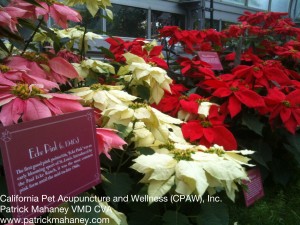 This article appeared on petMD as part of Dr Mahaney’s The Daily Vet series.
Now that Halloween and Thanksgiving are fading memories (but for those awesome pet photos you posted on Facebook), society is thrust into the cluster of holiday festivities that close out the calendar year.
Halloween celebrates candy and costumes (see Dr. Patrick’s Top Holistic Halloween Pet Safety Tips), while Thanksgiving emphasizes bountiful foods and home decor (see Wishbones, Candles, and Schedule Changes Pose Thanksgiving Pet Dangers).
Before we know it, Hanukkah, Christmas and other holidays will be upon us. While decorating your dwellings with greenery or accepting floral gifts (or re-gifts), be aware of the potential for toxicity that festive plants can have for pets.
Here is my list of common winter holiday plants and the clinical signs our canine and feline companions can exhibit post-ingestion.
Amaryllis (Amaryllis sp.)
The Amaryllis is a favorite of mine, as only appropriate water and light are seemingly required to generate a spectacular flower. Unfortunately, the beauty of the Amaryllis is matched by its toxicity.
The Amaryllis contains Lycorine and other noxious substances, which cause salivation, gastrointestinal abnormalities (vomiting, diarrhea, decreased appetite, and abdominal pain), lethargy, and tremors in both cats and dogs. The bulb of the plant is reputed to be more dangerous than the flowers and stalk.
The Amaryllis also goes by other names, including Belladonna, Saint Joseph Lily, Cape Belladonna, and Naked Lady.
Christmas Cactus (Schlumbergera bridgesii)
I have propagated my personal collection of Christmas Cactuses from larger plants hailing from Washington, Massachusetts, and Northern and Southern California. Of these four plants, only my Southern California variety produces flowers, which are white instead of the classic fuchsia.
Fortunately, if my canine companion Cardiff was to eat Christmas Cactus plant parts or flowers (or its relative, the Easter Cactus), he would suffer no direct toxic effects. The same lack of toxicity applies for cats. Yet, fibrous plant material causes mechanical irritation to the stomach and intestine, leading to vomiting or diarrhea.
Holly (Ilex opaca)
Your pet’s Christmas will not be so "holly-jolly" if Holly berries or leaves are consumed. Holly’s toxicity "stems from" (botanical humor) saponins, which are soap-like chemicals known as glycosides. In dogs and cats, consumption of Holly causes gastrointestinal signs and lethargy.
House Pine (Araucaria heterophylla)
As a child, I loved the responsibility of adorning my family’s pine tree with well placed lights and commemorative decorations. I didn’t consider the possible toxic effects pine trees have on our companion animals until witnessing them first hand while working as an emergency veterinary technician.
There are a variety of pine trees that have the potential for causing toxicity, including the Australian, Norfolk, and Norfolk Island Pine. Beyond the gastrointestinal signs caused by pine needles' mechanical irritation, the toxic action is unknown (unlike the other plants on this list).
Additionally, the water used to nourish a pine tree can be quite noxious. Bacteria, molds, and fertilizers can cause your pet to become extremely sick with only a few laps.
American or European Mistletoe (Phoradendron flavescens)
Mistletoe, often used as an accessory to amorous advances, contains multiple substances that are toxic to both dogs and cats, including toxalbumin and pharatoxin viscumin (Lectins, Phoratoxins). Consumption of mistletoe berries or leaves can cause severe gastrointestinal, cardiovascular (low blood pressure, low heart rate), and neurologic (collapse, unusual behavior) signs.
Poinsettia (Euphorbia pulcherrima)
This plant is seemingly synonymous with Christmas and has an unnecessarily bad reputation for toxicity. As the Poinsettia has such holiday ubiquity, it is frequently ingested by our pets.
Fortunately, toxicology studies do not confirm the common perception of the poinsettia’s exceedingly harmful effects. It is still best that your pet does not eat any part of the plant, as the poinsettia contains a latex-like sap that causes oral irritation and vomiting.
Prevention and Treatment of Holiday Plant Ingestion
Ultimately, the best method for protecting your pet from inappropriate ingestion of a toxic plant is to keep your home free of holiday greenery. Alternatively, you can obstruct your pet’s access (especially in your absence) and use positive reinforcement (treats, toys, etc.) to promote avoidance.
If your pet shows signs of illness in the presence of a holiday plant, you should suspect the plant’s inappropriate ingestion as the cause. Contact the ASPCA Animal Poison Control Center (APCC) or Pet Poison Helpline (PPH) to determine the best treatment. Keep in mind that more than one toxic substance can be involved; therefore seeking an APCC or PPH consultation and pursuing treatment with a veterinarian are vitally important.
This article appeared on petMD as part of Dr Mahaney’s The Daily Vet series.
Now that Halloween and Thanksgiving are fading memories (but for those awesome pet photos you posted on Facebook), society is thrust into the cluster of holiday festivities that close out the calendar year.
Halloween celebrates candy and costumes (see Dr. Patrick’s Top Holistic Halloween Pet Safety Tips), while Thanksgiving emphasizes bountiful foods and home decor (see Wishbones, Candles, and Schedule Changes Pose Thanksgiving Pet Dangers).
Before we know it, Hanukkah, Christmas and other holidays will be upon us. While decorating your dwellings with greenery or accepting floral gifts (or re-gifts), be aware of the potential for toxicity that festive plants can have for pets.
Here is my list of common winter holiday plants and the clinical signs our canine and feline companions can exhibit post-ingestion.
Amaryllis (Amaryllis sp.)
The Amaryllis is a favorite of mine, as only appropriate water and light are seemingly required to generate a spectacular flower. Unfortunately, the beauty of the Amaryllis is matched by its toxicity.
The Amaryllis contains Lycorine and other noxious substances, which cause salivation, gastrointestinal abnormalities (vomiting, diarrhea, decreased appetite, and abdominal pain), lethargy, and tremors in both cats and dogs. The bulb of the plant is reputed to be more dangerous than the flowers and stalk.
The Amaryllis also goes by other names, including Belladonna, Saint Joseph Lily, Cape Belladonna, and Naked Lady.
Christmas Cactus (Schlumbergera bridgesii)
I have propagated my personal collection of Christmas Cactuses from larger plants hailing from Washington, Massachusetts, and Northern and Southern California. Of these four plants, only my Southern California variety produces flowers, which are white instead of the classic fuchsia.
Fortunately, if my canine companion Cardiff was to eat Christmas Cactus plant parts or flowers (or its relative, the Easter Cactus), he would suffer no direct toxic effects. The same lack of toxicity applies for cats. Yet, fibrous plant material causes mechanical irritation to the stomach and intestine, leading to vomiting or diarrhea.
Holly (Ilex opaca)
Your pet’s Christmas will not be so "holly-jolly" if Holly berries or leaves are consumed. Holly’s toxicity "stems from" (botanical humor) saponins, which are soap-like chemicals known as glycosides. In dogs and cats, consumption of Holly causes gastrointestinal signs and lethargy.
House Pine (Araucaria heterophylla)
As a child, I loved the responsibility of adorning my family’s pine tree with well placed lights and commemorative decorations. I didn’t consider the possible toxic effects pine trees have on our companion animals until witnessing them first hand while working as an emergency veterinary technician.
There are a variety of pine trees that have the potential for causing toxicity, including the Australian, Norfolk, and Norfolk Island Pine. Beyond the gastrointestinal signs caused by pine needles' mechanical irritation, the toxic action is unknown (unlike the other plants on this list).
Additionally, the water used to nourish a pine tree can be quite noxious. Bacteria, molds, and fertilizers can cause your pet to become extremely sick with only a few laps.
American or European Mistletoe (Phoradendron flavescens)
Mistletoe, often used as an accessory to amorous advances, contains multiple substances that are toxic to both dogs and cats, including toxalbumin and pharatoxin viscumin (Lectins, Phoratoxins). Consumption of mistletoe berries or leaves can cause severe gastrointestinal, cardiovascular (low blood pressure, low heart rate), and neurologic (collapse, unusual behavior) signs.
Poinsettia (Euphorbia pulcherrima)
This plant is seemingly synonymous with Christmas and has an unnecessarily bad reputation for toxicity. As the Poinsettia has such holiday ubiquity, it is frequently ingested by our pets.
Fortunately, toxicology studies do not confirm the common perception of the poinsettia’s exceedingly harmful effects. It is still best that your pet does not eat any part of the plant, as the poinsettia contains a latex-like sap that causes oral irritation and vomiting.
Prevention and Treatment of Holiday Plant Ingestion
Ultimately, the best method for protecting your pet from inappropriate ingestion of a toxic plant is to keep your home free of holiday greenery. Alternatively, you can obstruct your pet’s access (especially in your absence) and use positive reinforcement (treats, toys, etc.) to promote avoidance.
If your pet shows signs of illness in the presence of a holiday plant, you should suspect the plant’s inappropriate ingestion as the cause. Contact the ASPCA Animal Poison Control Center (APCC) or Pet Poison Helpline (PPH) to determine the best treatment. Keep in mind that more than one toxic substance can be involved; therefore seeking an APCC or PPH consultation and pursuing treatment with a veterinarian are vitally important.
 Thank you for reading my article. To receive my next article via email, sign up by following this link.
Please feel free to communicate with me through Twitter (@PatrickMahaney) and follow my adventures in veterinary medicine by friending Patrick Mahaney: Veterinarian Acupuncture Pain Management for Your Pets on Facebook.
Copyright of this article (2011) is owned by Dr. Patrick Mahaney, Veterinarian and Certified Veterinary Acupuncturist. Republishing any portion of this article must first be authorized by Dr. Patrick Mahaney. Requests for republishing must be approved by Dr. Patrick Mahaney and received in written format.
Thank you for reading my article. To receive my next article via email, sign up by following this link.
Please feel free to communicate with me through Twitter (@PatrickMahaney) and follow my adventures in veterinary medicine by friending Patrick Mahaney: Veterinarian Acupuncture Pain Management for Your Pets on Facebook.
Copyright of this article (2011) is owned by Dr. Patrick Mahaney, Veterinarian and Certified Veterinary Acupuncturist. Republishing any portion of this article must first be authorized by Dr. Patrick Mahaney. Requests for republishing must be approved by Dr. Patrick Mahaney and received in written format.
